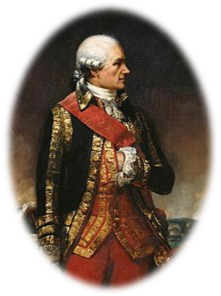Bienvenue en France!
Le chapitre de Rochambeau, National Society Daughters of the American Revolution (NSDAR ou DAR), rassemble des femmes dont les ancêtres patriotes américains et français ont participé activement à la guerre d’indépendance américaine (1775-1783).
Avec ses racines biculturelles et des membres internationaux de diverses générations, le chapitre Rochambeau de la NSDAR poursuit activement les objectifs historiques, éducatifs et culturels communs de la NSDAR, tout en promouvant l’amitié franco-américaine au quotidien.

Nouvelles du Chapitre

Jean-Baptiste Donatien de Vimeur, Comte de Rochambeau (1725-1807)
Le Comte de Rochambeau était un général français nommé par le roi Louis XVI pour apporter une aide vitale au général George Washington pendant la guerre d’indépendance américaine.
Ses remarquables qualités de tacticien et de meneur d’hommes ont contribué de manière décisive à la victoire des patriotes américains lors de la bataille de Yorktown, en Virginie (19 octobre 1781).
Le courage des soldats et des marins français qui ont combattu aux côtés des patriotes américains pendant la guerre d’indépendance américaine a permis la naissance d’une nouvelle nation – les États-Unis d’Amérique.



MEMORIAL DAY 2024
🇺🇸 To commemorate the memory of those Americans who made the ultimate sacrifice for freedom, the American Battle Monuments Commission is honored to invite you to the Memorial Day 2024 Ceremony.
The Escadrille La Fayette Memorial commemorates the courage and sacrifice of the 250 American pilots who enlisted under the French flag even before the United States entered the war in April 1917, under the name of the "La Fayette Flying Corps". The 68 members of the La Fayette Escadrille who died during the war are buried in the crypt under the arch of the memorial and their two French commanders, who died in 1948 and 1950, are buried there alongside their American comrade.
🇫🇷 Afin de commémorer le souvenir des Américains tombés au champ d’honneur pour défendre la cause de la Liberté, l’American Battle Monuments Commission a l’honneur de vous inviter à la cérémonie du Memorial Day 2024.
Le Mémorial de l’Escadrille La Fayette commémore le courage et le sacrifice des 250 pilotes américains qui se sont engagés sous le drapeau français avant même l’entrée en guerres des Etats-Unis en avril 1917, sous la dénomination de « La Fayette Flying Corps ». Les 68 membres de l’Escadrille La Fayette morts pendant la guerre sont inhumés dans la crypte située sous l’arche du mémorial et leurs deux commandants français, morts en 1948 et 1950, ont d’y être inhumés aux côtés de leurs camarades américains. ... Voir plusVoir moins
0 CommentairesComment on Facebook
❤️🇺🇸🇫🇷❤️ Merci pour le partage ! ... Voir plusVoir moins
This content isn't available right now
When this happens, it's usually because the owner only shared it with a small group of people, changed who can see it or it's been deleted.0 CommentairesComment on Facebook
Merci pour le partage !On May 2nd, 1780, Rochambeau and the Expédition Particulière departed from Brest, France for America. Though the French originally only supplied the colonies with covert financial aid and supplies, after the British defeat at the Battle of Saratoga they saw an opportunity in the colonies and signed the Treaty of Alliance. The Treaty recognized America’s independence and also promised direct military support. That support came in the form of 5,500 soldiers under the command of Rochambeau, who arrived in Narragansett Bay on July 11.
Once in America, Rochambeau and his forces camped in Newport, Rhode Island for roughly a year before proceeding to march south in coordination with Washington’s forces. In October of 1781, they arrived in Yorktown, Virginia, where they proceeded to surround and force the surrender of General Cornwallis, ending the war.
Pictured:
The Outer Harbor of Brest. By Louis Nicolas Van Blarenberghe, 1773.
#AmericanRevolution #Americanhistory #Militaryhistory #vivelafrance #Frenchhistory #18thcentury #colonialhistory #colonial #18thcenturyhistory #navalhistory #historical #Americancolonialhistory ... Voir plusVoir moins
1 CommentaireComment on Facebook
« Louis Nicolas Van Blarenberghe a magnifiquement illustré le port de Brest au moment du départ du Corps expéditionnaire envoyé par Louis XVI commandé par le général de Rochambeau, pour aider les colons Américains à gagner leur indépendance. »
Merci pour le partage !Today marks the anniversary of the return of Rochambeau’s son to Boston aboard the Concorden with cash for his father’s army and news there would be no 2nd division arriving from France. This meant that the Expédition Particulière, as it stood, was all the aid colonial forces would be receiving in terms of manpower from France.
When the elder Rochambeau landed in Newport in 1780, a harsh winter and the presence of the British navy occupying Narragansett Bay prevented his and Washington’s forces from meeting. Thus, the pair communicated through correspondence and infrequent camp visits when they could be afforded. Meanwhile, Rochambeau took his time in Newport to grasp his position and learn to communicate better with Americans. During this period Rochambeau recognized the dire situation the colonies were in and decided to send his son back to France to request more aid. Despite the denial, Rochambeau’s initial force proved sufficient and played a pivotal role in our victory over the British.
Pictured:
The Vicomte de Rochambeau later in his adult life. By H. Boisselier, circa 19th century.
#Americanhistory #AmericanRevolution #RevolutionaryRhodeIsland #RevolutionaryRI #NewEngland #NewEnglandhistory #militaryhistory #Newport #newportri #18thcentury #colonialhistory #colonial #18thcenturyhistory #onthisday #thisdayinhistory ... Voir plusVoir moins
1 CommentaireComment on Facebook
Thank you for the history lesson! 🇫🇷🇺🇸
Merci pour le partage ! ... Voir plusVoir moins
0 CommentairesComment on Facebook
www.facebook.com/share/ux5sr8rt1b4qskHk/?mibextid=WC7FNe ... Voir plusVoir moins
0 CommentairesComment on Facebook